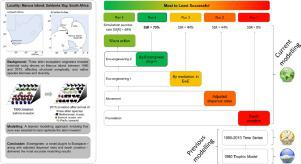Ecological Modelling ( IF 3.1 ) Pub Date : 2021-09-09 , DOI: 10.1016/j.ecolmodel.2021.109731 Saachi Sadchatheeswaran 1 , George M. Branch 1 , Lynne J. Shannon 1 , Marta Coll 2, 3 , Jeroen Steenbeek 3

|
In a prequel to this paper, we used non-spatial temporal modelling to investigate the impact of non-native ecosystem engineers on a small-scale, intertidal rocky shore in Saldanha Bay, on the west coast of South Africa, where invasive species have changed the physical environment between 1980 and 2015. However, we considered this approach incomplete without the direct inclusion of spatial modelling and zonation. To address this, we compared multiple, layered simulations employing the food-web approach of Ecospace, the spatial-temporal module of Ecopath with Ecosim (EwE). Our simulations included a control; a simulation that restricted drivers to depth and habitat preferences; two simulations to account for structural complexity as a function of the biomass of alien ecosystem engineers – the first indirectly via mediation, and the second via a novel plug-in ‘Ecoengineer’ – and lastly the inclusion of wave action to replicate its effects. Only the simulation that included the Ecoengineer routine matched empirical observations of species diversity indices and the exclusion of the native mussel Choromytilus meridionalis by the arriving alien Mytilus galloprovincialis. Inclusion of mediation did not differ from the model simulation that used only habitat preference and depth to drive the model, and the addition of wave action did not improve model fits. Our results emphasise that when analysing intertidal ecosystems, they should be modelled with an explicit representation of structural habitat complexity over time and space, and we consider that the application of our Ecoengineer plug-in is an effective and novel way of accomplishing this.
中文翻译:

一种明确模拟外星生态系统工程师在海洋底栖环境中创造的结构复杂性的时空影响的新方法
在本文的前传中,我们使用非时空模型来研究非本地生态系统工程师对南非西海岸萨尔达尼亚湾的小规模潮间带岩石海岸的影响,在那里入侵物种发生了变化1980 年至 2015 年之间的物理环境。然而,如果没有直接包含空间建模和分区,我们认为这种方法是不完整的。为了解决这个问题,我们比较了采用 Ecospace 的食物网方法的多个分层模拟,Ecopath 的时空模块与 Ecosim (EwE)。我们的模拟包括一个控制;将驾驶员限制在深度和栖息地偏好的模拟;两个模拟将结构复杂性解释为外星生态系统工程师生物量的函数——第一个通过中介间接,第二个是通过一个新的插件“生态工程师”——最后是包含波浪动作来复制它的效果。只有包含 Ecoengineer 例程的模拟才与物种多样性指数的经验观察相匹配,并排除了本地贻贝 Choromytilus meridionalis 由到达的外星人 Mytilus galloprovincialis制成。包含中介与仅使用栖息地偏好和深度来驱动模型的模型模拟没有区别,并且波浪作用的加入并没有改善模型拟合。我们的结果强调,在分析潮间带生态系统时,它们应该使用结构栖息地复杂性随时间和空间的明确表示进行建模,我们认为应用我们的生态工程师插件是实现这一目标的有效且新颖的方法。



























 京公网安备 11010802027423号
京公网安备 11010802027423号